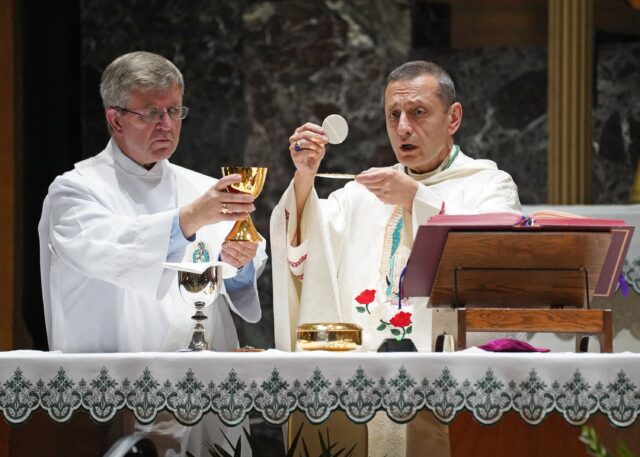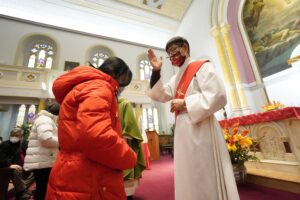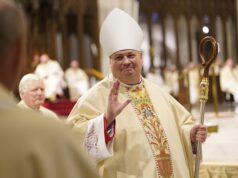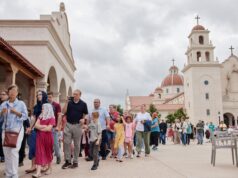
The number of permanent deacons in America is holding relatively steady, but more than a third of them are also at or approaching the required retirement age for many dioceses. According to experts, the situation may suggest a need for local churches to revisit the Second Vatican Council’s vision for the permanent diaconate and rethink how to invite men to discern the vocation.
On June 17, the U.S. Conference of Catholic Bishops’ Committee on Clergy, Consecrated Life, and Vocations released its annual survey, “A Portrait of the Permanent Diaconate in 2023: A Study for the United States Conference of Catholic Bishops.”
Since 2005, the Center for Applied Research in the Apostolate — a national, nonprofit research center at Georgetown University that conducts social scientific studies for and about the Catholic Church — has released the survey, which provides both statistics and forecasts trends for the permanent diaconate in the U.S. Catholic Church.
The estimated number of permanent deacons in active ministry was 13,718 in 2023, roughly 69% of all permanent deacons in the Latin Church.
There were 587 men ordained to the permanent diaconate in 2023, and since 2014, the estimated number of ordinations averaged 613.
“There’s no big change or shift,” said Jesuit Father Tom Gaunt, executive director of CARA. “I think what we see is that we have an increasing number of retired deacons — they’re well into their late 70s, 80s.”
While those deacons often still serve, “we have a few more who are dying each year than are being ordained,” Father Gaunt observed. “The total number of active deacons has gone down just a little bit; very small. Whereas the total number of retired deacons has increased.”
As Catholic News Service reported in 2021, “retirement age differs from diocese to diocese. Forty-two percent of dioceses have no retirement age for deacons. Of the others, no diocese requires deacons to retire until they reach at least age 70, while 88% require retirement at ages 75-79, and 10% mandate retirement at ages 70-74. One percent does not require retirement until at least age 80.”

The CARA survey — which utilized contact information from the National Association of Diaconate Directors, or NADD — was sent to the Office of the Permanent Diaconate in Latin and Eastern (arch)dioceses and eparchies. CARA received responses from 128 of the 185 (arch)dioceses/eparchies whose bishops are members of the USCCB — and have an active Office of Deacons — for a 69% total response rate.
The Archdiocese of Chicago had the most permanent deacons (827), followed by the Archdiocese of New York (357), Archdiocese of San Antonio (346), Archdiocese of Galveston-Houston (308), and Diocese of Joliet in Illinois (307).
“Essentially, it seems about the same as the previous one,” said Deacon Bill Ditewig, former executive director of the USCCB’s Secretariat for the Diaconate. “But there’s still some areas of concern — the major one, in my opinion, being the age situation.”
“One of the things that I think people forget — when you just look at the naked statistics — is that Vatican II’s vision was of a younger diaconate,” noted Deacon Ditewig, who has held multiple academic and diocesan posts.
“In fact, some of the original proposals were that married guys could be ordained deacons at the age of 40 — and then during the debates during the (Second Vatican) Council, that was determined to be too old, and they lowered it to 35,” he said. “Now when you do that — and then look at the statistics — less than 1% of deacons are under the age of 40. You kind of have to say, ‘Has the vision met the reality here?'”
If the diaconate becomes a retired, “second career” vocation, Deacon Ditewig emphasized, “it’s not what the original vision was supposed to be” — which included bringing a diaconal witness to the secular workplace.
Deacon Ditewig also noted the American diaconate’s ethnic makeup.
Most permanent deacons are Caucasian/white (73%); followed by Hispanic/Latino (20%); Asian/Pacific Islander (3%); African American/Black (3%); and Native American/other (1%).
“That’s been a concern of the bishops since 1971,” shared Deacon Ditewig, “because again, a key part of the diaconate was to be with people where they are, where they live and where they work.”
Deacon Ditewig said some dioceses discourage younger vocations to the diaconate, reasoning, “You’re at the beginning of your career; your career is about to go on a different path; you’ve still got young children at home — why don’t you wait awhile.”
Deacon Ditewig, 74, was ordained at 40, with four children at home.
“The fact is, it worked out to be the perfect time for our family. And so what we have found over the years, sometimes, is that dioceses will set standards that if you still have minor age children at home, then don’t apply. It’s almost building in an age situation,” said Deacon Ditewig, who added that some men discerning a diaconal vocation — seeing so many older deacons serving — assume that candidates have to be retired.
“The attitude that many of us have is, let discernment do its thing — if this is the right time for this family, it will be demonstrated,” he stressed. “If it’s the wrong time for this family, that will come up, too. But the bottom line of all this is, that we’re talking about a vocation from God.”
Deacon Dominic Cerrato, director of the Office of the Diaconate for the Diocese of Joliet, and editor of OSV’s The Deacon magazine, agreed. (OSV is the parent company of OSV News.)
“The unfortunate thing is that many priests and many deacons — and I don’t want to be sweeping here, but I think it’s true — discourage young men from becoming deacons,” said Deacon Cerrato, who was ordained a deacon at 35, the youngest canonical age allowed. “We had five children at the time; we eventually had seven children. It is possible — and I think that those years served me and the church well. But many, many were discouraged from coming, and told ‘raise your family.'”
That mindset, Deacon Cerrato said, can largely be traced to a faulty understanding of the nature of vocation that proposes “God calls you in one ear for marriage, and then calls you in the other ear for the diaconate — and you’re split,” he explained. “No — because God doesn’t speak out of both sides of his mouth. It’s one single call — of which the two are integrated in.”
Still, given the persistence of that outlook, “It’s very possible that there are many more people who are younger,” observed Deacon Cerrato. “We just haven’t called them.”
That is not, however, the case in the Diocese of Joliet, where there are 307 permanent deacons, and many younger candidates are being called. “We’re seeing a rise in our numbers,” Deacon Cerrato reported.
“The single most vital development regarding the state of the diaconate in the U.S.,” said Deacon James Keating, a professor of spiritual theology at Kenrick-Glennon Seminary in St. Louis and a member of the Academy of Catholic Theology, “will be if diocesan seminaries begin to form seminarians in a mature theology of their own impending diaconate, and that this formation extends to a thorough appreciation for the vocation of the permanent diaconate.”
“Further,” Deacon Keating continued, “priest-deacon fraternity will only reach a place of abiding respect if the quality of diaconal formation in dioceses deepens in the areas of scriptural knowledge, liturgical competency, homiletical giftedness, ministerial wisdom to and for married couples, prudent leadership in the works of charity, and the unleashing of desire for contemplative prayer.”
The divergence between a secular and spiritual outlook also must be addressed, said Deacon Keating.
“Deacon formation programs should be encouraged to instill within the deacon an ecclesial imagination to replace a very stubborn cultural one,” he suggested. “Possessing an ecclesial imagination will go a long way in securing a true brotherhood of clerics within the ranks of priests and deacons.”
Reflecting on the survey results, Deacon Cerrato offered both an inquiry and a suggestion.
“There’s a larger question here. Why is God calling men to the diaconate? Why is it arguably the largest growing segment in the church today, certainly in the West? What is God saying?” he asked. “And I suspect he’s saying that the reason for this is that Christ the Servant needs to be made present in a world that is so turned in on itself that it fails to see that service is the way you discover yourself.”








